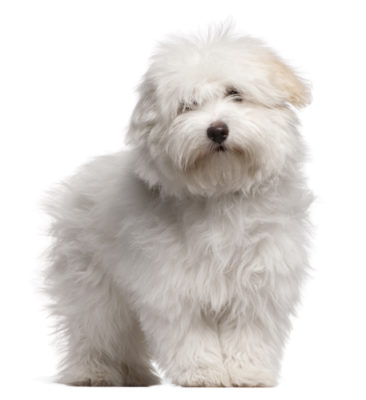
Where the Coton de Tulear originated before it found its way to the island of Madagascar in the 16th century isn’t known with certainty, but most believe it to be an ancient breed with early roots in Central Asia. Some cynologists believe that the breed is descended from the Bichon Tenerife, others insist that it descended from the Maltese. In truth, the Coton’s origins will probably always be disputed, if not remain a mystery. As to how the dogs arrived in Madagascar, theories abound there, as well. A common hypothesis is that dogs aboard a ship swam to shore following a major shipwreck off the southern coast of Madagascar. Others maintain that it was more likely that the little dogs traveled with trade caravans and on ships as ratters, and arrived when ships put in at Port Tulear. Still another view is that the dogs were brought to Southern Madagascar by people from the islands of Reunion and Mauritius. It’s known that European settlers colonized the Mauritius and Reunion in the 16th and 17th Centuries, and that they had Bichon-type dogs with them, a breed known as the Bichon de Reunion. Traders probably acquired the dogs on Reunion and Mauritius and introduced them to the Merina people, one of Madagascar’s most powerful groups.
However the breed actually arrived in Port of Tulear, these dogs may have bred with Malagasy pariah-type dogs, and a local hunting dog known as the Morondava Hunting Dog. The Merina kept the puppies that were born, and owning one came to be a status symbol across the island, a visual indicator of power, wealth, and prestige.
In 1890, the French government officially annexed Madagascar. French officials and soldiers may have crossed their own dogs – Bichons, Maltese, and Bolognese – with local Cotons de Tulear with the thinking that the crosses would improve the breed. It’s probable a few of the resulting dogs were taken back to France by colonial officials, but the Coton remained virtually unknown outside of Madagascar.
This changed when the island achieved full independence in 1960. Tourism grew as word spread of Madagascar’s unusual geography and wildlife. Tourists were met at the airport by Malagasy groups wearing traditional costume, and they had in their arms their island’s native dogs. Many tourists bought Cotons de Tulear that way.
Too many, in fact. The Coton de Tulear became a hot commodity. Substandard breeders and shady sellers started to pass off anything that resembled a fuzzy white canine as a purebred Coton de Tulear. In 1970, the president of the Canine Society of Madagascar officially petitioned the FCI for full recognition for the breed to protect it. Even after acceptance, however, the demand for Cotons was insatiable. So many dogs were exported to Europe that by 1980, Malagasy government had to limit the number of Cotons that could be exported from the island to 200 dogs per year because the breed had became so rare on the island of its origin.
The first Coton de Tulear arrived in America in 1974, and in 1976, the first Coton puppy was born in the United States. The United Kennel Club recognized the Coton in 1996 as a member of its Companion Dog Group, and the AKC officially entered the Coton de Tulear into its Foundation Stock Service in 2009, will full recognition coming in 2014.
Image: Malagascy postage stamp

i’ve had this unusual dog that I found on the streets of California in the Mojave desert and could not figure out what type of dog he was for several years. He had died in the home of his owner and has been looking for his owner for over three years. Obviously it was a white gentleman with white hair as anytime I took him anywhere with that description of a gentleman fit the bill he would jump right in the car with him. It was not until he swallowed some plastic and had to have exploratory surgery that he actually bonded to me from taking care of him so doting. . Although I have a pack of nine he requires special attention all the time like being hand fit one piece of his food at a time. He is truly dedicated and devoted to me and there is no other breed that I can compare him to since I have many other dogs and I also train dogs for a living now that I am retired. I have never seen a Nother one yet in the US and had the most difficult time just scrolling through tons of research to figure out exactly what he was and I’m so happy that I did. They have amazing qualities and I would love to know even more about them. This guy is very special to me and although I don’t play favorites in my pack and like Pacc excepts dogs that come in and out for different training routines such as service animals, ESA‘s, medical service dogs etc. they except all of them regardless of who they are and what their condition is. This guy gets along with everybody and doesn’t think there’s a bad person or a bad dog in the world and has no bad bones in his body he’s absolutely remarkable! Anytime I find information on them I try to read whatever I can to learn more about him as he is truly a one person dog and he really does not want to share his household with nine other dogs. However, he has to get used to it because I am also a rescue person
Such a wonderful story, Alyson, thank you for sharing it with us, and for taking in this little guy!